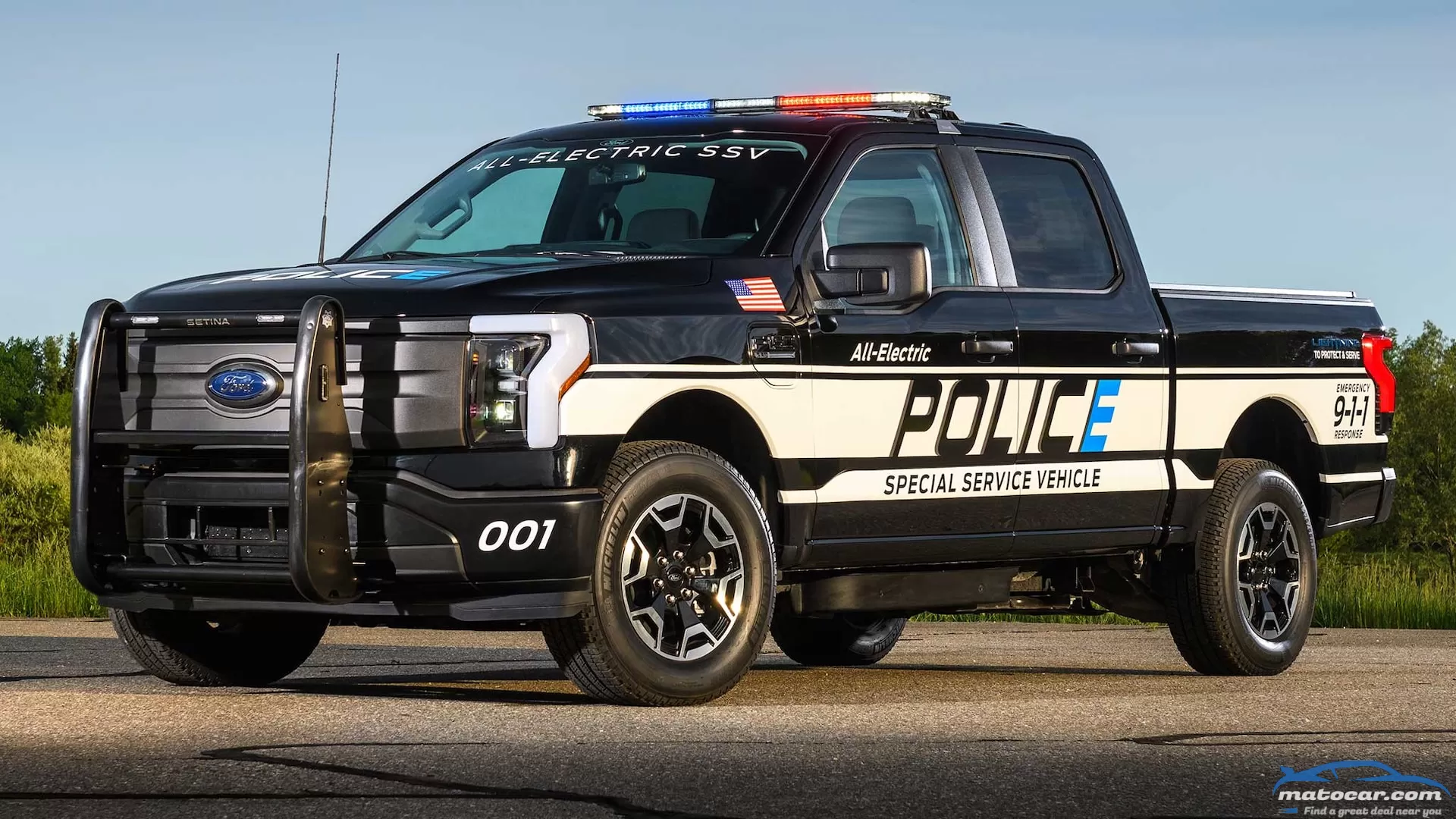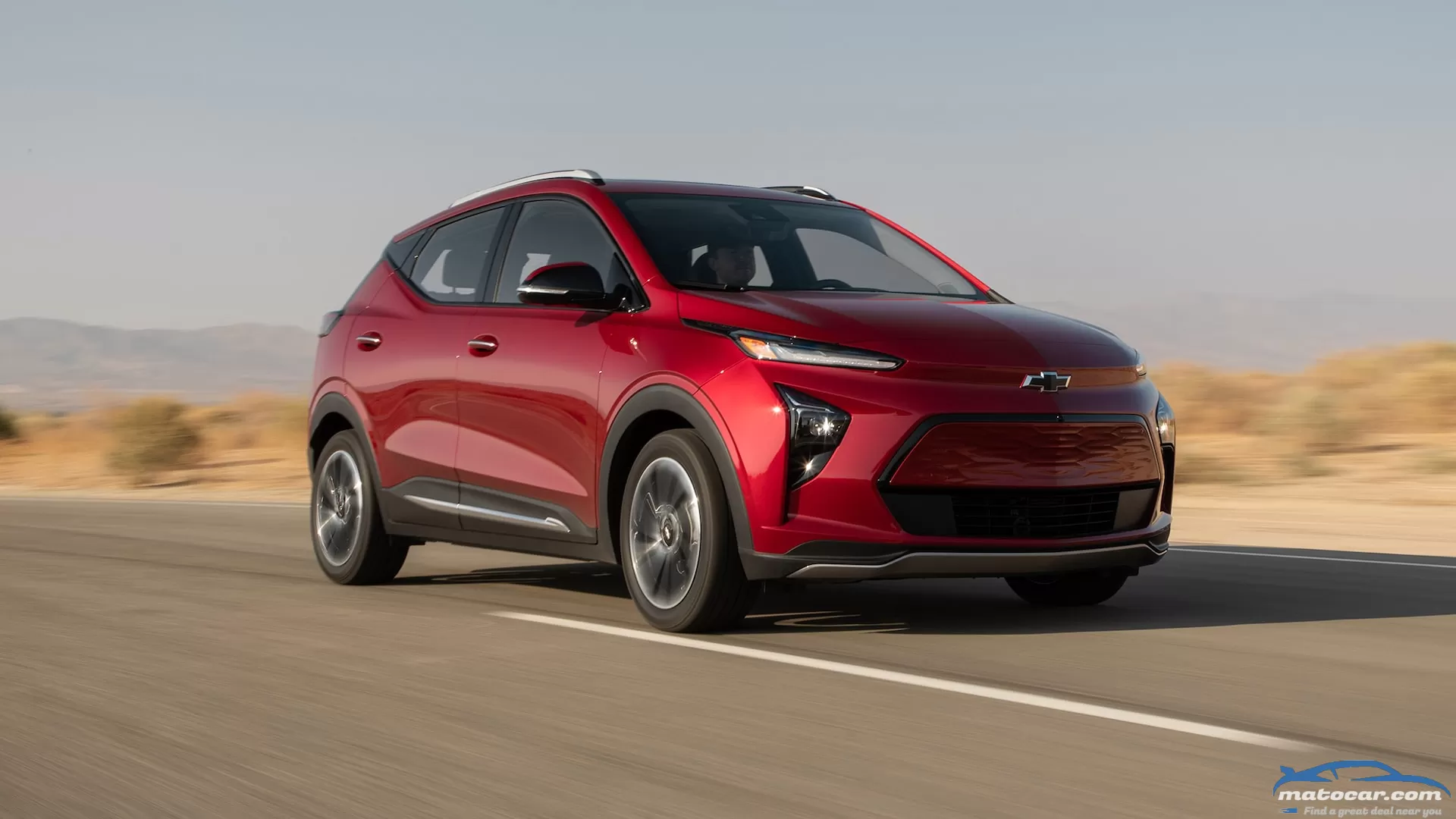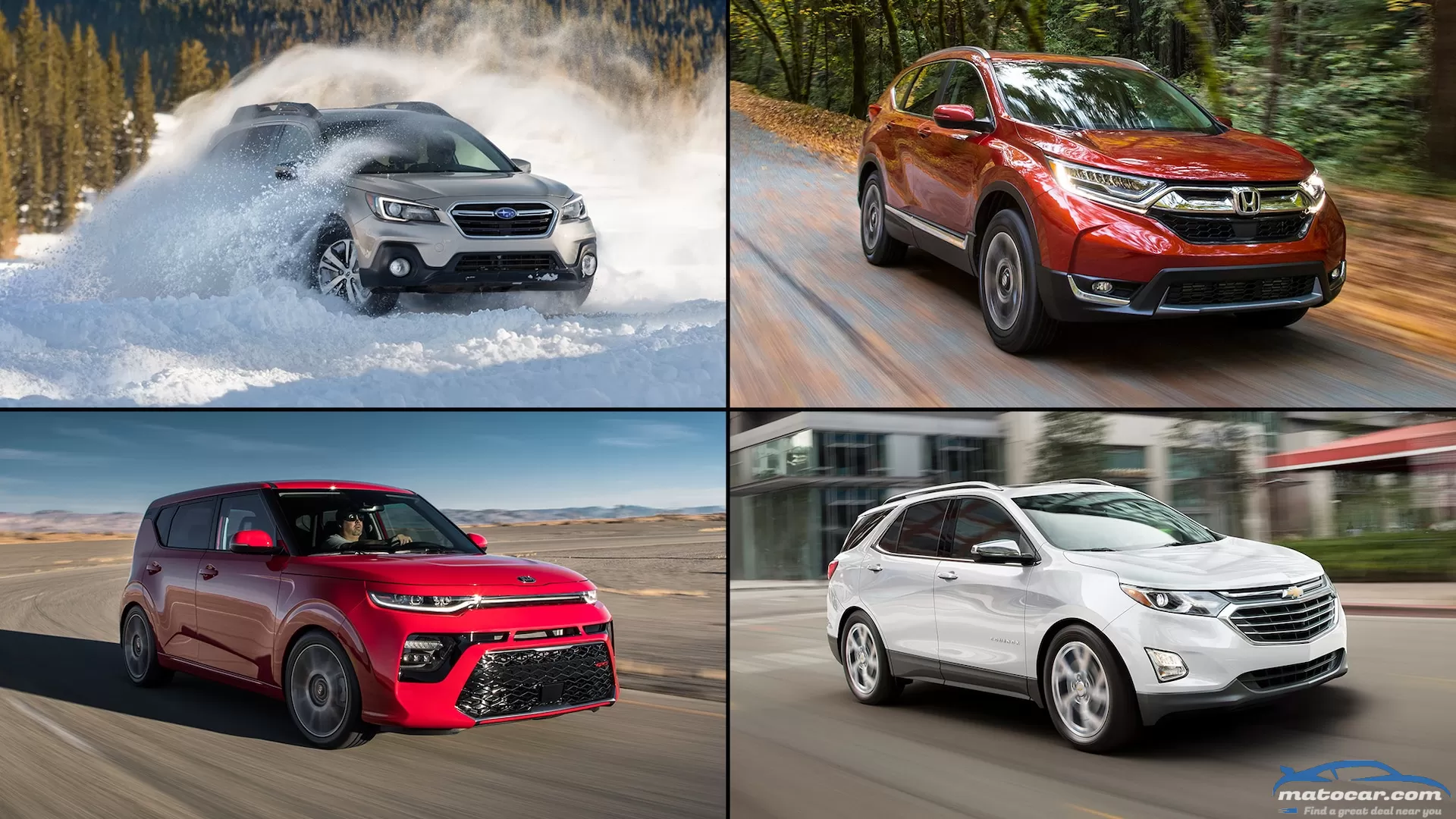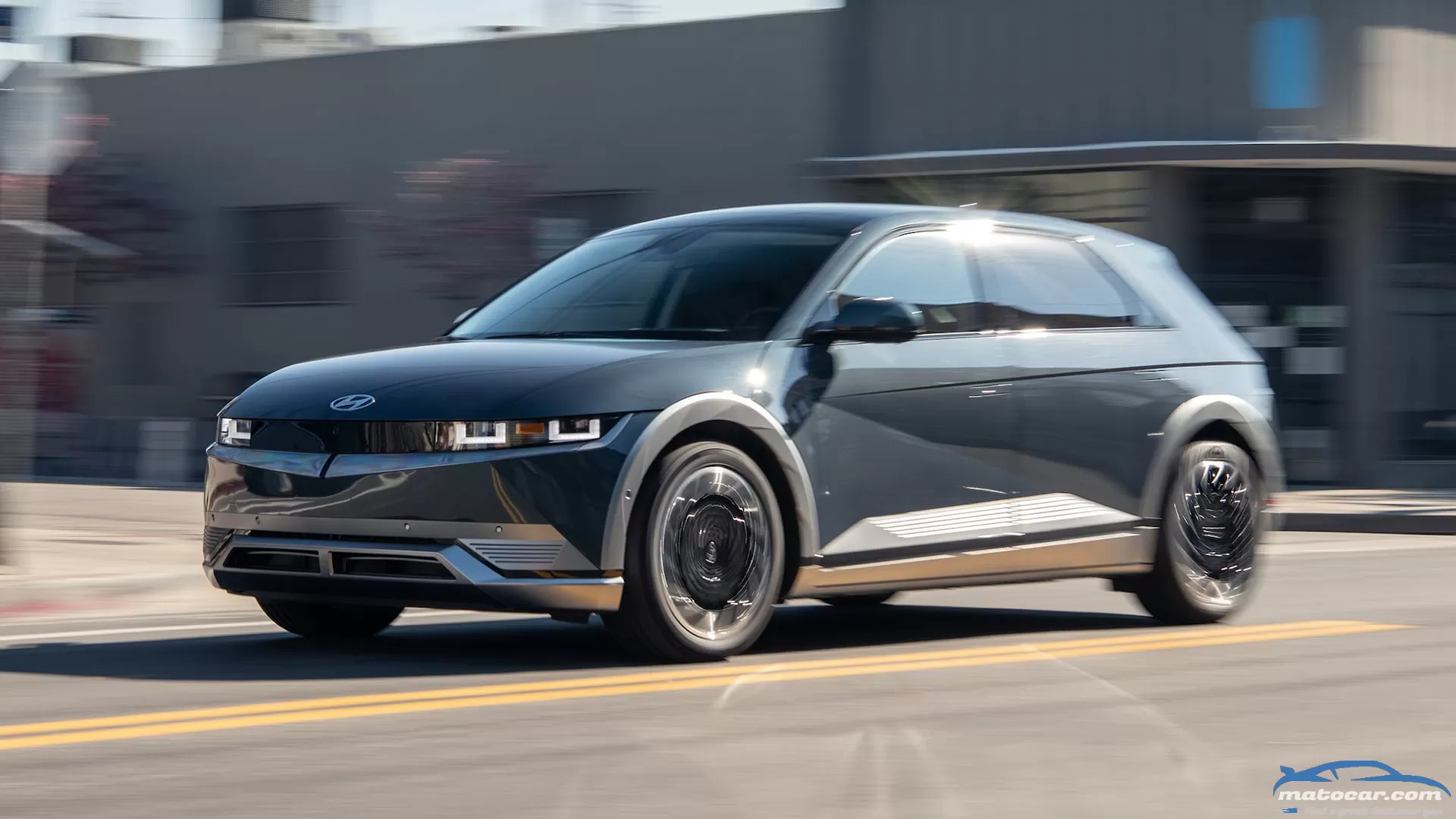Ford F-150 Lightning Goes to the Police Academy, Sprouts Light Bar

You have the right to remain electric. Anything you put in the bed or rear seat can be used against your driving range. You have the right to a charger. If you cannot find one, one may be installed for you.
Consider these the new Miranda rights for police forces across America, which soon will have access to Ford's new F-150 Lightning Pro SSV police truck. The new cop pickup is spun off the all-electric Lightning, and while that part is novel, the package is, for the most part, modeled after the regular F-150 Police Responder rig.
One thing the Lightning Pro SSV is not is pursuit-rated. This is purely a patrol and response vehicle, even though the standard-range battery version's dual electric motors combine for 452 hp and 775 lb-ft of torque, and the big-battery, long-range model gets 580 hp and the same mighty torque figure. In that latter configuration, Ford claims the Pro SSV (that's Special Service Vehicle) can hit 60 mph in under four seconds, a claim largely backed up by our test figures for the new Lightning. In extended-range battery form, but without the range-topping Platinum trim's bigger wheels and extra equipment, an F-150 Lightning Lariat model scooched to 60 mph in 3.8 seconds.
Okay, so "technically" the police Lightning won't be used for chases or other action. For those tamer missions, it's well equipped. Take the "Pro" part of its name. That's a reference to the entry-level Pro trim level on the civilian F-150 Lightning, which already is geared toward work duty with vinyl seats and flooring and a more basic interior layout. Ford swaps in cloth-wrapped front seats for the SSV, which also include steel "anti-intrusion" plates in the seatbacks and slimmer bolsters to make it easier for cops and their nifty tool belts to slide in and out.
And then there is the frunk, which offers 14.1 cubic feet of space under the power-opening hood in the truck's nose for storing cop things. There also is a 220-amp DC-DC power source under there, which any number of upfitter attachments can be wired to. Oh, and the top of the dashboard is reinforced so it can withstand use as a mounting point for various add-ons.
Ford also will install the requisite red-and-blue or white-and-amber roof lights for departments that request it. And beyond the lighting on the truck itself, Ford points out that the ProPower Onboard power sources in the frunk and bed can be used to power accident-scene lighting, emergency equipment, or mobile doughnut makers just as easily as the welders, fridges, and other stuff ProPower can handle for civilian Lightning customers.
So far, the police Lightning's range figures are TBD. Regular Lightnings can travel between 230 and 320 miles on a charge, depending on which batteries they come with. We've found that that range can vary wildly depending on what the truck is being used for (i.e., just noodling around, or towing a heavy trailer). More details will arrive later this summer, both for the Pro SSV and, it seems, the 2023 model-year Lightning generally. That gives you a few more months of police vehicles that can't sneak up on you silently.
You may also like
chevrolet bolt-euv Full OverviewWhen Chevrolet first introduced the Bolt EV, it sent shockwaves through the automotive industry as the first properly affordable mainstream electric car. More than half a decade later, Chevy has taken its award-winning hatchback (it took home the 2017 MotorTrend Car of the Year award) and spun off a second model, the stretched Bolt EUV crossover. We put the 2022 Chevrolet Bolt EUV to the test to see if it could recapture the original's magic.Disappointing Dynamics At a glance the Bolt EUV doesn't look all that different from its smaller sibling, though it drives like an entirely different vehicle. It wears a similar grille and retains the Bolt EV's egglike styling. However, the 2022 Chevy Bolt EUV is 0.2 inch taller and wider and 6.3 inches longer than the regular Bolt. It's 90 pounds heavier, too.The Bolt EUV develops 200 hp and 266 lb-ft of torque, which it sends through the front wheels. Range is 247 miles on a full charge, 12 miles less than the Bolt EV. Chevy claims the Bolt EUV can regain 95 miles of range in 30 minutes depending on how much charge is already in its 65-kWh battery, which seemed to be a realistic assertion based on our lunchtime top-off after three laps of our Car of the Year test loop.Although the Bolt EUV's throttle mapping is good, it's easy to roast the tires at a whim, as its economy-minded rubber provides little grip off the line or even at moderate speeds if the driver dabs the accelerator too hard. We managed a 0-60-mph sprint of 6.7 seconds, which is quick but not as quick as the car feels from the driver's seat. Brake pedal tuning is excellent for an electric vehicle, as it feels completely natural and predictable. However, despite having a lot of the ingredients that make a car fun to drive, they don't come together in a cohesive way.On our test route, we found the Bolt EUV to have substandard body control and rough suspension tuning. In fact, the rear torsion bar banged so hard over train tracks that it sounded like something broke (it didn't). "This was one of the most poorly behaved vehicles driven over these surfaces," MotorTrend technical director Frank Markus said. "Lots of harshness, lots of bottoming and topping of the suspension." It's not all bad news, however, as the Chevy's steering stood out as one of the car's best aspects; it offered good engagement and ample feedback.On open stretches of highway and around town, the 2022 Chevrolet Bolt EUV was a bit more pleasant due to its low-end torque and excellent battery-regeneration features. The EV offers one-pedal driving with the push of a button, allowing it to use regenerative braking. It's a remarkably intuitive system and brings the Bolt EUV down from speed with firm stopping power without jarring the vehicle's occupants. The neat regeneration paddle on the steering wheel is still present, allowing for firm but controlled deceleration that feeds electricity back into the battery. Although it's not the most entertaining car to drive on back roads, these features are as amusing as they are useful.Creature ComfortsThe interior, though an improvement over the original Bolt EV's cockpit in terms of materials and layout, still feels at least half a decade old. It also looks like it's at least half a generation older than the other electric crossovers it competes with. That's because of Chevy's pervasive use of hard plastics throughout the cabin, though our test car featured sweet-looking blue seats and door pocket inserts that made it appear a bit more premium. Ventilated seats were also a huge win, seeing as we conducted our testing under the hot desert sun.There's plenty of space up front with 44.3 inches of legroom, and most rear passengers will have room to stretch out a bit with 39.2 inches. Although the Bolt EUV is a wagonoid crossover, its trunk space is limited with just 16.3 cubic feet of capacity behind the rear seats. That's pitiful compared to the Ford Mustang Mach-E's 29.7 cubes. Chevy makes the storage area a bit more flexible with a removable floorboard, but it helps demonstrate this vehicle is more of a spruced-up hatchback than a full-on crossover.Is the Bolt EUV Safe?Although the 2022 Chevrolet Bolt EUV isn't the sleekest package, it comes equipped with an impressive suite of driver assistance features, including automatic emergency braking, forward collision alert, lane keeping assist with lane departure warning, following distance indicator, automatic high-beams, and front pedestrian braking.GM's Super Cruise semi-autonomous system, an available feature on the Bolt EUV, came equipped on our test car. It's the first Chevy to offer this system; the package costs $2,200 and adds hands-free driving on roads included within GM's software. We've been impressed with Super Cruise before, and it continues to work exceptionally well on the Bolt EUV. The car kept its place in the lane without error so long as there were lines on either side of the vehicle, and it controlled its speed well and hustled up the hills on our test route without slowing down. Buyers shopping for a mainstream EV with a system that bests Tesla's Autopilot may want to consider purchasing the Bolt EUV with Super Cruise.Tech TalkChevrolet did a great job integrating the 10.2-inch infotainment display into the center stack. The Infotainment 3 Plus with Navigation is easy to operate and quick to respond to inputs. It isn't standard; however, it comes as part of the $2,495 Sun and Sound package, which also adds a Bose seven-speaker audio system and a sunroof.The front USB ports are difficult to access; they're wedged deep in the cellphone cubby. It's tough to dig a mobile device out of the compartment, too, leading to some awkward maneuvering in the cabin when it's time to hop out of the car. There isn't much going on in terms of tech in the back seat; passengers have access to just one USB-A and one USB-C port.Pricing and ValueAt an as-tested price of $43,685, this 2022 Chevrolet Bolt EUV Premier jolted us with sticker shock. That's $5,190 more than the Premier trim package and $9,690 above the EUV's $33,995 base price. Chevy is asking a lot of money for a new model that feels a lot more like a refreshed 5-year-old car, but we concede the entry-level model represents a much better deal than the example we evaluated here.Simply put, where the Chevy Bolt once stood out as an isolated example of a well-executed and affordable EV, the EUV model lacks the polish we now expect from an electric car. During our SUV of the Year testing, the Bolt EUV had below-average range compared to the other EVs we tested, and our judges were unimpressed by its handling and ride composition. Prospective buyers might want to opt for a lesser trim level to improve the bang-for-buck ratio.The VerdictChevrolet should have taken extra measures to button up this new model, a vehicle that represents the company's next step toward total electrification. The 2022 Chevrolet Bolt EUV would have been a spectacular car five years ago, but EVs have progressed so much that this represents a mid-segment offering at best. For many, it will deliver ample capability for daily driving, but shoppers should consider other "every-person" electric crossovers such as the Ford Mustang Mach-E and Volkswagen ID4, as well, for more modern approaches to mainstream EVs.Looks good! More details?
The double whammy of increasing fuel and vehicle prices has a lot of SUV shoppers not knowing which way to turn. A more efficient modern ride could ease the pain at the pump, but with inflation and rising borrowing costs, many are delaying big-ticket purchases like new cars. Expanding a search to include slightly used SUVs with strong fuel economy might be the way to go if you're looking for an alternative.Knowledge is power, and in our methodology below, you'll find how we came to our tally. Most of the SUVs on this list are subcompact and compact crossovers, but a single midsize offering also managed to qualify. All received an EPA combined fuel economy rating of 27 mpg or greater, and a couple of the entries can be found priced from roughly $15,000. Keep reading to find out which used SUVs under $30,000 have the best fuel economy.About MotorTrend's methodology: The Buyer's Guide recognizes how important a used car purchase can be, which is why we take this so seriously. Our methodology considers many of the same factors in our new-car rankings system, starting with value. The experts at IntelliChoiceconduct extensive research to assess long-term value on 3-5-year-old vehicles, which means our picks start at the 2018 model year. IntelliChoice considers resale value, the cost of insurance, maintenance costs, fuel costs, and more. We prioritize models receiving a Good or Excellent IntelliChoice used-car value rating. An above-average J.D. Powerquality and reliability rating is also a plus. Any vehicle we recommend must have earned anIIHSTop Safety Pick award or NHTSA overall five-star safety rating, and have some used-car inventory with under 80,000 miles (the upper limit on many automaker CPO programs).
hyundai ioniq-5 Full OverviewThe 2022 Hyundai Ioniq 5 is the most consequential new Hyundai since the original Genesis sedan. The Genesis changed people's perception of Hyundai as a brand, for the first time putting the Korean automaker in the luxury conversation alongside names such as Mercedes-Benz, BMW, and Lexus. The new 2022 Hyundai Ioniq 5 is destined to change the perception of Hyundai again—only this time the conversations will be around Tesla.What Is It?The Ioniq 5 is the first Hyundai EV built on Hyundai Motor Group's Electric-Global Modular Platform (E-GMP). The Ioniq 5 is available worldwide with either a 58-kWh or 77.4-kWh battery pack and a single motor driving the rear wheels or (with the 77.4-kWh battery) motors front and rear providing all-wheel drive. In North America, the 77.4-kWh battery pack is the sole option.Even by the standards of today's topsy-turvy automotive taxonomy, the 2022 Hyundai Ioniq 5 is something of a segment buster. In photos, its crisp styling and taut proportions suggests a Veloster-sized hatchback with a sort of Hyundai-does-VW-Golf vibe. Look again and consider: It's rolling on 20-inch wheels and 255/45 Michelin Primacy Tour tires. In the metal, the Ioniq 5 is almost as big as a BMW X3, with a 118.1-inch wheelbase—that's an inch longer than a BMW X5's.Car Style, SUV SubstanceOur test vehicle is the range-topping 2022 Hyundai Ioniq 5 Limited HTRAC, which comes equipped with the big battery and all-wheel drive courtesy of two motors that produce a total of 320 hp and 446 lb-ft of torque. It also boasts a swag of premium goodies ranging from a power driver's seat with memory to a high-end Bose audio system to a head-up display and adaptive cruise control. You get all of this for $55,725.That's considerably less money than you'll spend for a dual-motor Tesla Model Y Long Range, which is listed at $60,900. What's more, the Hyundai looks and feels like a much more premium product. Where the Model Y's cabin is stark and austere, the Hyundai Ioniq 5's interior is thoughtfully detailed and well-finished, and it has buttons and knobs and targeted touch panels that mean you don't have to waste time looking away from the road to peck furiously at a giant screen to access mundane functions as you do in the Tesla. And while from the outside the Model Y looks as if it's been thrown together in a tent, with inconsistencies in the panel fits you can see from, er, Mars, the Hyundai's fit and finish is first rate.Testing, TestingThe new Ioniq 5 initially feels like a softer car to drive than many of its EV contemporaries, with its suspension seemingly tuned more for comfort than corners. But that's not to say it's slow. At the test track, the 0-60-mph sprint took just 4.4 seconds en route to a standing quarter-mile time of 13.2 seconds at 102.7mph. And unlike some EVs—the Ford Mustang Mach-E GT Performance Edition is a notable example—the Hyundai's rate of acceleration didn't fall off dramatically as speeds increased. Instead, it was able to sustain its forward push right through the quarter mile.Yes, the Tesla Model Y Long Range is quicker overall, whooshing down the quarter mile in 12.4 seconds at 114.8 mph, but the difference between the two is mostly at high speed, which has little relevance in real-world driving. The Hyundai's superior torque—its twin motors produce an additional 70 lb-ft compared to the Tesla—effortlessly punches the Ioniq 5 away from a standstill, and it's only 0.3 second slower to 60 mph than the 7 percent lighter and 20 percent more powerful Model Y.Despite its soft suspension, the Hyundai Ioniq 5 is surprisingly adept in the twisty bits. We recorded a figure-eight lap time of 25.7 seconds, just 0.2 second slower than the BMW X3 M40i we happened to test on the same day. This caused us to exclaim, "Holy smokes!" Frankly, we didn't expect this car to be as fun and capable as it is; it's quick and has way more grip than we anticipatedThe biggest surprise was how playful the Ioniq 5 can be on corner exits with all the nannies switched off: It actually drifts. Just for fun, we tried for a full sideways lap of the skidpad, and the Hyundai made it two-thirds of the way around before letting go.The asymmetric front-to-rear power and torque split of the dual-motor Ioniq 5—the front motor makes 99 hp and 188 lb-ft, while the rear pumps out 225 hp and 258 lb-ft—combined with near neutral front/rear weight distribution doesn't just make the Hyundai a giggle when you want to play at the track. It also makes it feel more poised on normal roads at normal speeds, despite steering that, though precise and direct, doesn't provide a lot of feedback.Brake feel is the car's biggest dynamic niggle. The blending between regenerative and mechanical braking is smooth, and the system hauled the 4,684-pound Hyundai to a stop from 60 mph in 123 feet, 5 feet more than the Tesla Model Y required. But we disliked the lack of feedback through the pedal: There's very little travel or pedal pressure under heavy braking before the ABS kicks in.More DetailsYou can actuate one of three drive modes—Eco, Normal, and Sport—via a large button beneath the steering wheel's left spoke. In simple terms, the modes change the weighting of the accelerator pedal, effectively encouraging the driver to make smoother and gentler inputs. Six regenerative braking levels are offered, ranging from zero (which allows the Ioniq 5 to coast freely) to a mode that enables one-pedal driving, with the car slowing to a gentle halt the moment you lift off. There is also an auto mode. Drivers can switch between these modes via steering wheel paddles.After a bit of experimentation, we preferred to set the drive mode to Sport, which allowed us to make the most of the powertrain's instant-on response, and the lift-off regenerative braking to Level 1, which enabled the 2022 Hyundai Ioniq 5 to flow down the road much like a regular combustion-engine car with an automatic transmission when lifting off the accelerator.Range FinderHyundai says the 77.4-kWh battery gives the dual-motor Ioniq 5 a range of 256 miles. Our stints on the road, which included highway cruising at 70 to 80 mph and some brisk bursts along quiet back roads, as well as endless fiddling with drive modes and regen settings, saw the Ioniq 5 consume 2.7-kWh per mile, according to the onboard computer, which translated to a range of just about 200 miles. Driven normally, you should expect a usable range of 220 to 230 miles, more if you are content to noodle along in Eco mode.No, the Ioniq 5 Limited won't travel as far between charges as the Tesla Model Y Long Range, which has a claimed range of just more than 300 miles. But you'll spend about 30 percent less time at the charging station with the Hyundai. Find a 350-kW DC fast charger, and the Ioniq 5's battery can be juiced from 10 percent charge to 80 percent in just 18 minutes and topped up fully in less than an hour. No other mainstream EV, apart from the identical-under-the-skin Kia EV6, can recharge so quickly.Do You Want One?In terms of overall practicality, the 2022 Hyundai Ioniq 5 is a mixed bag. The long wheelbase and flat floor mean the rear seat easily accommodates 6-foot-tall adults, and there's plenty of storage space around the cabin. But unlike most two-box SUVs, it is truly a hatchback, not a wagon. The raked C-pillars and angled backlight chew into the shallow load space at the rear, and there's only a small storage tray in the frunk.If driving range and load lugging are your absolute priorities, the Tesla Model Y Long Range, which will travel 28 percent farther between charges and has about 60 percent more luggage capacity with the rear seats up, would seem the obvious choice. But those two advantages come at a price.The Ioniq 5 Limited not only costs about $5,000 less than the Model Y, but it's also quieter and more comfortable to drive, is a visibly higher-quality vehicle inside and out, and can recharge much quicker. That it's also brisk and fun to drive if you want it to be are bonuses.Indeed, the 2022 Hyundai Ioniq 5 Limited HTRAC is a compelling all-arounder for the buyer who wants a premium EV, without paying top dollar.Looks good! More details?2022 Hyundai Ioniq 5 HTRAC (Limited Long Range) SPECIFICATIONS BASE PRICE $55,725 PRICE AS TESTED $55,920 VEHICLE LAYOUT Front and rear-motor, AWD, 5-pass, 4-door SUV MOTOR TYPE Permanent-magnet electric POWER (SAE NET) 320 hp TORQUE (SAE NET) 446 lb-ft TRANSMISSION 1-speed automatic CURB WEIGHT (F/R DIST) 4,684 lb (51/49%) WHEELBASE 118.1 in LENGTH x WIDTH x HEIGHT 185.2 x 74.4 x 63.0 in 0-60 MPH 4.4 sec QUARTER MILE 13.2 sec @ 102.7 mph BRAKING, 60-0 MPH 123 ft LATERAL ACCELERATION 0.88 g (avg) MT FIGURE EIGHT 25.7 sec @ 0.71 g (avg) EPA CITY/HWY/COMB FUEL ECON 110/87/98 mpg-e EPA RANGE, COMB 256 mi ON SALE Early 2022 Show All




0 Comments